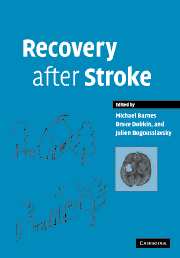Book contents
- Frontmatter
- Contents
- List of authors
- Preface
- 1 Stroke: background, epidemiology, etiology and avoiding recurrence
- 2 Principles of recovery after stroke
- 3 Regenerative ability in the central nervous system
- 4 Cerebral reorganization after sensorimotor stroke
- 5 Some personal lessons from imaging brain in recovery from stroke
- 6 Measurement in stroke: activity and quality of life
- 7 The impact of rehabilitation on stroke outcomes: what is the evidence?
- 8 Is early neurorehabilitation useful?
- 9 Community rehabilitation after stroke: is there no place like home?
- 10 Physical therapy
- 11 Abnormal movements after stroke
- 12 Spasticity and pain after stroke
- 13 Balance disorders and vertigo after stroke: assessment and rehabilitation
- 14 Management of dysphagia after stroke
- 15 Continence and stroke
- 16 Sex and relationships following stroke
- 17 Rehabilitation of visual disorders after stroke
- 18 Aphasia and dysarthria after stroke
- 19 Cognitive recovery after stroke
- 20 Stroke-related dementia
- 21 Depression and fatigue after stroke
- 22 Sleep disorders after stroke
- 23 Technology for recovery after stroke
- 24 Vocational rehabilitation
- 25 A patient's perspective
- Index
13 - Balance disorders and vertigo after stroke: assessment and rehabilitation
Published online by Cambridge University Press: 05 August 2016
- Frontmatter
- Contents
- List of authors
- Preface
- 1 Stroke: background, epidemiology, etiology and avoiding recurrence
- 2 Principles of recovery after stroke
- 3 Regenerative ability in the central nervous system
- 4 Cerebral reorganization after sensorimotor stroke
- 5 Some personal lessons from imaging brain in recovery from stroke
- 6 Measurement in stroke: activity and quality of life
- 7 The impact of rehabilitation on stroke outcomes: what is the evidence?
- 8 Is early neurorehabilitation useful?
- 9 Community rehabilitation after stroke: is there no place like home?
- 10 Physical therapy
- 11 Abnormal movements after stroke
- 12 Spasticity and pain after stroke
- 13 Balance disorders and vertigo after stroke: assessment and rehabilitation
- 14 Management of dysphagia after stroke
- 15 Continence and stroke
- 16 Sex and relationships following stroke
- 17 Rehabilitation of visual disorders after stroke
- 18 Aphasia and dysarthria after stroke
- 19 Cognitive recovery after stroke
- 20 Stroke-related dementia
- 21 Depression and fatigue after stroke
- 22 Sleep disorders after stroke
- 23 Technology for recovery after stroke
- 24 Vocational rehabilitation
- 25 A patient's perspective
- Index
Summary
Introduction
Postural control is a complex function that involves most brain areas (Horak and MacPherson, 1996). Many brain lesions may cause a perturbation of postural control, and postural disorders represent one of the most frequent disabilities after stroke. Their nature and their severity depend on the ability of undamaged brain areas to compensate, therefore on age (Pérennou et al., 1999) and premorbid status, as well as on lesion size (Pérennou et al., 1999, 2000) and location (Viallet et al., 1992; Dichgans and Fetter, 1993; Brandt and Dieterich, 1994; Palmer et al., 1996; Ioffe, 1997; Miyai et al., 1997; Karnath et al., 2000a; Pérennou et al., 2000).
After a stroke, the ability to maintain or to change a position can be altered in the three basic postures: lying, sitting, and standing. Consequently, assessment of these critical postures is often standardized for clinical follow-up in terms of the ability to roll from supine to side lateral and vice versa; the ability to maintain an independent sitting posture without any extension of support (buttocks on a bed or a physiotherapy couch and feet on the floor); the ability to rise up from a chair; and the ability to stand unaided. The assessment of gait ability require other specific tools that are beyond the topic of this chapter.
One week after stroke, about 40% of patients are not able to roll from supine to side lateral (Partridge and Edwards, 1988). On day 30 after stroke, only 60–70% of patients can perform this change of posture without any help (Benaim et al., 1999); 20–25% can do so with help (Benaim et al., 1999), and the other 10–15% are still not able to do so, always with more difficulty toward the non-affect side (Partridge and Edwards, 1988; Benaim et al., 1999). The restoration of an independent sitting posture is a key point for patient autonomy and so the sitting posture has long been one of the most frequently postures analyzed after stroke. Up to 75–80% of patients keep or recover the ability to maintain an independent sitting posture for several minutes within the first month (Perrigot et al., 1980; Sandin and Smith, 1990; Benaim et al., 1999).
- Type
- Chapter
- Information
- Recovery after Stroke , pp. 320 - 396Publisher: Cambridge University PressPrint publication year: 2005



